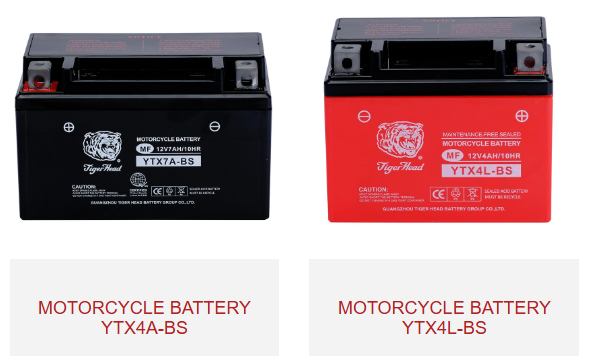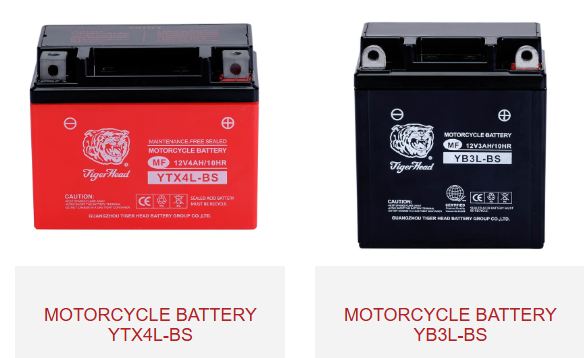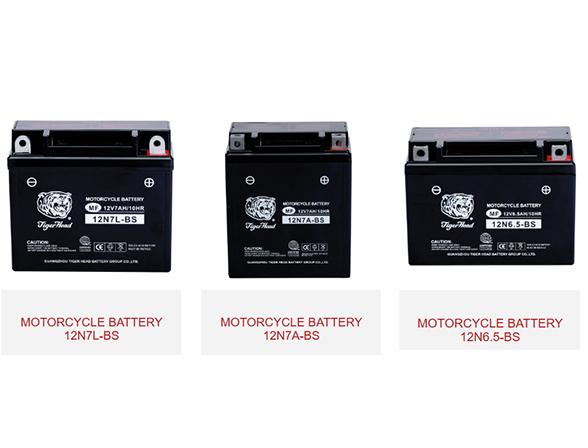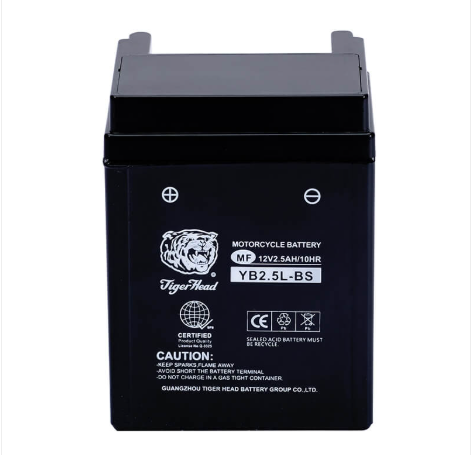Why Different Motorcycle Types Require Different Battery Features?
Choosing the right motorcycle battery involves more than simply matching voltage or physical dimensions. Different types of motorcycles, ranging from light scooters to heavy touring bikes, place vastly different demands on battery technology. These differences arise from variations in engine size, onboard electronics, starting requirements, riding environments, and vibration tolerance.
As a leading motorcycle battery brand, Tiger Head Battery provides batteries specifically engineered to meet these diverse technical requirements.
Power Demand Vary by Motorcycle Type
Scooters & Small Motorcycles (50cc–150cc)
- Typical Battery Features Required:
- Low cold-cranking amps (CCA)
- Lightweight, compact size
- Economical performance
These motorcycles typically use smaller batteries, such as the YTX4A-BS or YTX4L-BS. Their engines require relatively little starting power, and they have limited onboard electronics. AGM (Absorbent Glass Mat) sealed batteries are popular in this segment due to zero maintenance and spill-proof design.

Street Bikes (150cc–500cc)
- Battery Features Required:
- Higher CCA than scooters
- Reliable charge retention for daily start-stop riding
- Enhanced vibration resistance
Models such as YB3L-BS and YTX4L-BS are ideal for this category. While street bikes demand more starting power, weight and compactness are still priorities. These bikes may have additional electronics such as fuel injection or digital dashboards, requiring batteries with stable voltage output and improved cycle life.

Cruisers & Touring Motorcycles (500cc+)
- Battery Features Required:
- High-capacity for larger displacement engines.
- Ability to handle deep cycles (frequent start/stop).
- Stable output for power-hungry accessories (GPS, audio, lights).
- Extended lifespan under heavy load.
12N7A-BS, 12N7L-BS, and 12N6.5-BS batteries are designed for these demands. These batteries are typically larger in physical size and capacity, with deeper reserves to ensure consistent performance for long-distance riding, high compression engines, and numerous onboard devices.

Off-Road & Dirt Bikes
- Battery Features Required:
- Ultra-lightweight
- Extreme vibration and impact resistance
- Reliable cold starts in varied conditions
- Compact fit for small compartments
Off-road bikes favor rugged, compact batteries like YB2.5-BS. These environments prioritize shock-proof, sealed construction to withstand impacts and irregular terrain.

Technical Factors Behind Battery Differences
Cold Cranking Amps (CCA)
Cold Cranking Amps (CCA): Refers to a battery's ability to deliver starting current for 30 seconds at 0°F (-17.8°C). A higher CCA rating indicates stronger cold-weather starting performance.
- Larger engines require more CCA to turn over. Touring bikes need high CCA ratings; scooters require minimal CCA.
- Tiger Head Battery provides optimally rated batteries for all engine classes.
|
Engine Size |
Recommended CCA |
Example Models |
|
<150cc |
30–70 CCA |
YTX4A-BS, YTX4L-BS |
|
150–500cc |
80–120 CCA |
YB3L-BS, YB2.5-BS |
|
500cc+ |
150+ CCA |
12N7L-BS, 12N7A-BS |
Battery Chemistry: AGM vs Conventional
|
Type |
Advantages |
Application |
|
AGM |
Maintenance-free, sealed, vibration-resistant |
Modern street, touring, off-road (YTX series) |
|
Conventional |
Lower cost, requires maintenance |
Older motorcycles, basic applications (YB series) |
AGM technology (used in YTX models) provides superior vibration resistance and cold-start performance. Conventional batteries (YB series) offer affordability but require periodic electrolyte maintenance.
Vibration & Shock Resistance
Off-road and high-revving motorcycles expose batteries to significant mechanical stress. AGM batteries with internal glass mat structures (like YTX4A-BS) maintain performance where conventional flooded batteries would deteriorate quickly.
Discharge Cycles & Reserve Capacity
Touring motorcycles often run electronics (GPS, audio, lights) for extended periods, even while idling. Batteries like 12N7A-BS are engineered for deeper discharge cycles and sustained reserve capacity, preventing voltage drops during long rides.
Safety & Regulatory Compliance
Different motorcycles operate in environments with varying safety expectations. Tiger Head Battery designs its batteries to comply with:
- Tiger Head Battery complies with the IATF 16949 quality management system and is certified to JIS D 5302 (Japanese Industrial Standard for motorcycle battery safety) as well as CE/RoHS directives.
- Resistance to acid leaks, internal shorts, and explosive gas build-up
Sealed AGM batteries are strongly recommended in environments where vibration, heat, or orientation may cause conventional batteries to spill.
The Hidden Cost of Choosing the Wrong Battery
|
Wrong Fitment |
Potential Consequences |
|
Too small capacity |
Frequent failures, hard starting |
|
Incorrect CCA |
Poor cold weather performance |
|
No vibration resistance |
Early failure in harsh use |
|
Oversized battery |
Space fitting issues, weight drag |
How Tiger Head Battery Matches Every Motorcycle Type
Product Recommendations by Segment
|
Motorcycle Type |
Recommended Models |
|
Scooter / Small Bike |
YTX4A-BS, YTX4L-BS |
|
Street Bike |
YB3L-BS, YTX4L-BS |
|
Cruiser / Touring |
12N7L-BS, 12N7A-BS, 12N6.5-BS |
|
Off-Road / Dirt Bike |
YB2.5-BS, YB3L-BS |
Conclusion: One Size Does Not Fit All
Choosing the correct motorcycle battery isn't just about voltage—it's about matching technical specifications to the demands of your motorcycle's engine, environment, and usage.
From compact YTX4A-BS batteries for scooters to robust 12N7A-BS models for touring motorcycles, Tiger Head Battery delivers solutions tailored to real-world demands, engineered with precision and backed by a commitment to safety and reliability.
FAQ (Frequently Asked Questions)
Q1: How long does a motorcycle battery typically last?
The typical lifespan of a motorcycle battery ranges from 2 to 5 years, depending on factors such as battery quality, usage frequency, maintenance practices, and storage environment.
For example, Tiger Head Battery models such as YTX4A-BS, YTX4L-BS, YB3L-BS, YB2.5-BS, 12N7L-BS, 12N7A-BS, and 12N6.5-BS can achieve longer service life when properly maintained.
Q2: Why do different motorcycle engine types require different batteries?
Different engine sizes and motorcycle categories have varied demands for starting current (CCA), electrical load, and usage environments.
Smaller engines, like those in scooters, require lower-capacity batteries such as YTX4A-BS, while larger touring motorcycles need high-capacity batteries with deeper cycle capabilities, such as 12N7A-BS.
Q3: What is the difference between AGM batteries and conventional batteries?
AGM batteries (such as the YTX series) are maintenance-free, leak-proof, and highly resistant to vibration, making them ideal for modern motorcycles and harsh environments.
Conventional batteries (such as the YB series) are more affordable but require regular maintenance, including electrolyte checks, and are more susceptible to vibration.
If durability and stability are your priorities, Tiger Head Battery's AGM series is highly recommended.
Q4: What happens if I choose the wrong motorcycle battery?
Selecting the wrong battery (insufficient capacity or CCA) may lead to:
- Hard starting
- Reduced battery lifespan
- Cold start failures in winter
- Premature failure due to vibration
In severe cases, this may affect riding safety or cause electronic malfunctions.
Q5: Which Tiger Head Battery models are recommended for different motorcycle types?
|
Motorcycle Type |
Recommended Models |
|
Scooters |
YTX4A-BS, YTX4L-BS |
|
Street Bikes |
YTX4L-BS, YB3L-BS |
|
Off-Road / Dirt Bikes |
YB2.5-BS, YB3L-BS |
|
Cruisers / Touring |
12N7L-BS, 12N7A-BS, 12N6.5-BS |






